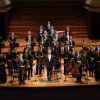Santiago Cañón-Valencia need only play a few bars to reveal why he’s hailed as a rising star.
The 30-year-old Colombian cellist delighted the audience at Stanford University’s Bing Concert Hall on Wednesday night with impeccable technique, sensitive dynamics, and lyrical musicality. Presenting a program that focused on French composers and featured uncommon transcriptions, Cañón-Valencia’s performance gained emotional depth and range as the evening unfolded.
Cañón-Valencia opened the concert with a transcription of Henri Duparc’s Lamento, supported by pianist Victor Santiago Asunción. The late Romantic composer was tormented by a neuropsychological condition and published only 13 songs in his lifetime. Lamento, a setting of a poem on grief by Théophile Gautier, is so brief — a mere two minutes — that it was hard to grasp the full weight of its melancholy, especially with latecomers in the audience still settling into their seats. It seemed that Cañón-Valencia had barely sat down before it was over, and his listeners had no time to meditate on its aching lines as the musicians plunged straight into the next piece with barely a pause.
Claude Debussy’s Cello Sonata gave listeners a better chance to admire Cañón-Valencia’s virtuosity. The lyrical theme of the Prologue showcased Cañón-Valencia’s wonderfully measured vibrato. He is wholly comfortable with letting notes linger as straight tones, so when his warm vibrato arrives it is all the sweeter.
In the jazzy, fantastical Serenade, Cañón-Valencia tackled the left-handed pizzicato and flute-like flautando bowing with precision and ease. He left no doubt as to why he has been feted with awards including silver medalist at the 2019 International Tchaikovsky Competition and was named a BBC Next Generation Artist in 2022.
Cañón-Valencia is not a flamboyant player, and from halfway across the vast hall, not much could be extracted from his restrained body language throughout the Sonata. Was he moved by the raw lament of the first movement? Was he having fun with the finale’s exuberant dialogue between piano and cello? It was hard to tell.
Those questions were forgotten with the arrival of l the second half of the evening, which had an intimacy and charm that made it even more enjoyable than the first.
With his instrument soaring over the rippling piano in Maurice Ravel’s Sonata in A Minor, originally scored for violin, Cañón-Valencia was transporting. He immersed his audience in the French composer’s impressionistic landscape as the dreamy melodies bloomed and filled the hall. His tender rendering of Pavane pour une infante défunte (Pavane for a dead princess), originally for solo piano, infused the piece with a sense of nostalgia, and one could imagine the titular little princess dancing with solemn grace.
Finally, the Vocalise-étude en forme de habanera is a virtuoso piece originally intended for bass voice. In the hands of Cañón-Valencia, the vocal melismas became fluid passages that wound with sultry grace over the insistent habanera rhythm in the piano. When he took his bows, Cañón-Valencia placed a hand over his heart. Indeed, these pieces were the emotional center of the night’s program.
Kudos must be given to Asunción, the Filipino American pianist who beautifully complemented Cañón-Valencia. At times, the heft of Bing’s Steinway overshadowed the cello’s lower range, but outside those rare moments, Asunción and Cañón-Valencia’s dialogue highlighted how the program’s pieces were not written simply for cello accompanied by piano, but rather were exemplars of chamber music, an interplay of equals.
The concert was completed with the Suite francaise by Francis Poulenc and the Suite italienne derived from Igor Stravinsky’s ballet Pulcinella.
Poulenc’s Suite francaise, originally written for winds, brass, percussion, and harpsichord, was slightly flattened without the snare drums energizing the opening Bransle or the bright bite of the harpsichord. Cañón-Valencia and Asunción’s version was nonetheless enjoyable. As they danced their way through the airy Sicilienne and the closing Carillon, it was undeniable that the duo was, indeed, having fun.
Stravinsky’s work was a better platform to show off Cañón-Valencia’s virtuosity with delicate trills, lush double-stops, and lively spiccatos. The lively whirlwind of the Tarantella, performed with gusto, drew an audible “oh!” of joy from an audience member when the last note struck.
As an encore, the cellist opted for Camille Saint-Saëns’s “The Swan”, in a warm and winsome reading, ending with a sustained, straight tone that floated over the piano’s final notes, releasing his audience into the night.
Cañón-Valencia will return to the Bay Area on Nov. 1 to perform Arturo Márquez’s “Espejos en la Arena” with the San Francisco Symphony in celebration of Día de los Muertos.




